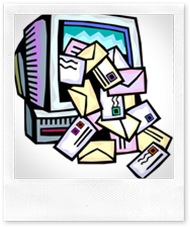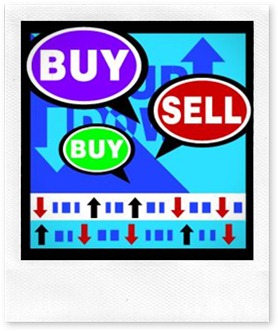Entries Tagged 'direct response copywriting' ↓
April 30th, 2010 — copywriter, direct response copywriting, sales writing

This is always a tough question to answer when putting together a sales letter.
Every product is different so the answer will depend on what you are selling. But what if you are trying to sell an information product – something along the lines of an eBook or report, for example. How much information do you ‘give away’ about it?
What can I do for you today?
It’s a bit like when you go into the hairdressers – do you opt for the full colour or just highlights?
Well, if you think about it – you are offering an information product. It will be designed to help your reader in some way. It may be designed to make them money, save them money, change their lifestyle, improve their careers – the possibilities are endless.
Because it will ‘change their lives’ you don’t want to tell all in your sales letter. If you did, what would be the point in buying the product?
Ben Settle makes an interesting analogy in his recent post ‘Hollywood’s Billion Dollar Copywriting Secret’ . When a new film is due for release, it is preceded by a trailer. This is designed to whet your appetite. As such, it involves a combination of high action snippets from the film set to enlivening music with a compelling and dramatic voice over.
Basically what they are doing, is giving you the edited highlights of the whole film. It will be the most dramatic sections that you see and when strung together, it will produce a powerful image.
Therefore when you’re putting your sales letter together you need to look at the most powerful benefits your product has – what is the greatest impact it will have on your reader? What is the problem they desperately need a solution to and that your product will provide.
It is these highlights you need to extract and place in your sales letter. You have to give them just enough to make them want more.
Whatever you’re selling, always concentrate on the main benefits of your product. Your reader is going to want to know what your product will mean to them. Give them what they’re looking for and they’ll buy.
Sally Ormond – freelance copywriter
February 19th, 2010 — copywriter, copywriting tips, direct mail campaign, direct response copywriting

Direct mail has been around for many years. Long before the internet was thought of letters would come crashing through your letter box promising all sorts of wonderful things.
It is one of those things you either love or hate. Personally I’m not a great fan but that is probably because I have seen so much bad direct mail.
Buy! Buy! Buy!
That is what immediately springs to mind whenever someone mentions direct mail.
There is so much today – on and off line – that shouts at you. Know what I mean? All those letters and landing pages that are a mix of fonts, font sizes, colours, bold text, underlining.
Why do it? Surely if your product is great and stands up on its own merits it doesn’t need all that fluff and decoration.
Surely concentrating on the benefits is the key. Tell me what it will do for me, how it will make my life better. Convince me of that and I’ll probably buy – if the price is right.
That’s another thing – the price.
Is the price right?
Only you know if the price you are asking is fair or not. When I say ‘is the price right’ I’m thinking more of where you’ve put it in your sales letter/landing page.
Often you’ll see it in the headline.
Only £5.99!
Great, but because you haven’t put forward your offer yet, what’s the point in thrusting the price at me? It is meaningless on its own.
It’s the same when the price precedes the benefits. You have to convince me that the benefits of your product are so strong I’ll want to buy it whatever the price.
Convince first, tell them the price later.
Forget the hype
Great swathes of writing going on and on and on about features, exaggerated claims and long winded testimonials can be a real turn off.
Yes, testimonials are strong but do you really need twenty of them?One or two persuasively written case studies would be far more powerful.
People today are very time limited. They don’t have hours or even minutes to waste wading through your longwinded letter or landing page.
If your offer demands longer copy, fine – so long as it is all relevant to your product. Long copy can be very effective when written well.
It’s very easy to write long copy badly – it’s not so easy to write good long copy.
Know who you are writing to
Another pet hate of mine is receiving direct mail that is of no interest to me whatsoever.
If you are sending off line direct mail make sure you do your market research well. There are three elements that make up a successful campaign:
- A great offer
- A great sales letter
- The right audience
Get any of those wrong and you’ll be doomed.
Even if you’ve slaved hours over your letter and written the strongest offer known to man, if you send it to a bad list you won’t get the return you are looking for.
There is money to be made
You’ve probably guessed by now that I’m not a great fan of this particular sales format. However as a copywriter it is something I am called on to do frequently for my clients.
Learning how to write it has been a long journey (it isn’t something you can pick up over night) and a tortuous one considering my feelings towards it.
But I quickly learnt that direct mail could be written without excessive hype, bold colours, odd fonts and flashing boxes (or those annoying pop-ups on landing pages that chase you round the screen asking if you are sure you want to leave the page).
So don’t be put off by my rant. Direct mail can and does work. There are many big corporations out there using is well. Its just a shame there are so many bad examples out there too.
What are your thoughts on it? Do you love it or hate it? It would be great to hear from you.
November 2nd, 2009 — copywriting tips, direct response copywriting, freelance copywriting

Life would be so much easier if we all have a crystal ball. But we don’t, so we have to rely on good old fashioned research with a dash of copywriting cunning.
You might think that writing a piece of direct mail is easy. All you need is a description of your product, the price, a method for the customer to get in touch to order your product and Bob’s your uncle.
Well, if that’s your approach, Bob won’t even be related to you because it won’t work.
Behind the innocuous façade of a direct mail letter lurks an array of mystical mechanics. In my last post, Direct Mail – The Copywriter’s Secret Weapon, I identified 4 factors that contribute to your campaign success – the list, the offer, the format and the copy.
To take things a step further, in this post I will explore the common magic ingredients that are required for effective direct response marketing, regardless of its format.
Get your offer out there – fast
This is the most obvious aspect but, surprisingly, one that is sometimes overlooked.
Get you offer out there immediately (in your heading) and then say it again, and again, and again. Copywriting is a lot like storytelling – you create a drama by showing your readers the power of your product and how it will benefit their lives. There are 2 different ways of achieving this:
- When your product is desirable (e.g. jewellery, holidays etc.)
Show your readers a vision in the header or opening paragraph using the benefits – looking good, showing great taste, enjoying a luxury holiday etc. This is the gold at the end of the rainbow.
Show your reader how and why the product you are offering will fulfil all their dreams and desires (and don’t forget to mention the offer again).
- Over coming pain and fear
This will help you by providing a formula for benefits that help you overcome things you don’t want like dirty clothes, higher taxes, ill health etc.
First describe the pain (e.g. disease, dirt etc.), then introduce your offer (laundry detergent, vitamins etc.) which is the cure and then follow it up with evidence of how your offer will cure the pain.
The carrot and the stick
This is a great tool within the freelance copywriter’s arsenal. It is a means of telling your reader that good things will happen if they respond to your offer and, of course, that there may be undesirable consequences if they don’t.
So, if you were selling washing power your offer would be a brand new scientifically proven formula that gets all your laundry clean first time.
Carrot – buy the detergent and enjoy sparklingly clean clothes forever and be incredibly successful in all that you do.
Stick – use your normal detergent, wear dull clothes and spend your life aspiring to be your friend who always looks clean and smart and is incredibly successful.
So there you go, direct response mail is much more than just throwing a sales letter together. The words that you use have to convince the reader that your product or service is right for them. My next post will look at the characteristics found in successful direct mail letters.
October 30th, 2009 — copywriting, copywriting tips, direct response copywriting, freelance copywriting

Direct mail is a very effective sales weapon, if you get it right.
There are 3 elements to direct response advertising that make it so successful:
- Appeals to a specifically targeted audience
- Written to inspire an action or response
- It can be measured to assess it effectiveness
Target your audience
Some methods of marketing involve sending out generic advertising to the general populous. This may achieve a wide distribution but much of the information will be wasted.
Why?
Because your sales pitch won’t be targeted at your ideal market.
The beauty of direct mail is that it is targeted to a specific audience. Your mailing list is the single most important aspect of your whole campaign. In fact, in order of importance, your direct mail campaign top 4 elements are:
- List – you can either buy this in or use your own which would have been built over time from past customers, newsletter sign ups etc.
- Offer – this will depend on what the desired response to your mailing is. It could be a free report, free shipping, BOGOF etc.
- Format – email, letter, gift, radio ad, TV ad etc.
- Copy – this must be customer orientated with a strong call to action
Get them to take action
The whole reason behind your direct mail campaign is to get a desired response from your prospects.
Whether that is to buy, sign up or make an appointment, your mailing should be designed to get the reader to make that response immediately.
Therefore you need to make it as easy as possible for them – provide a free phone number, enclose an SAE for their completed order form, give them a web address etc.
Always provide them with everything they need.
How did you do?
The only way to discover how effective your campaign has been is by measuring it.
If you are doing an electronic campaign your analytics will show you how successful your marketing drive was. But if you are sending a physical mailing you will need other methods of monitoring it.
Try a 0800 number specific to each campaign. If you are driving traffic to your website provide an offer code that has to be keyed in so you can track your website visitors. If you have sent SAEs mark the envelope with a code so their source can easily be identified.
If you make sure your direct response advertising covers all the elements shown above you should be well on your way to a successful marketing campaign.
Sally Ormond
Freelance Copywriter
July 15th, 2009 — copywriting services, direct response copywriting, freelance copywriting
A great sales letter can stand between you and a small fortune. By getting the content, tone and sales pitch right you could open up a whole new world of customers. But writing the perfect sales letter isn’t easy.
In my post Copywriting – The Sales Letter I talked about the mechanics of the sales letter and its 3 main components – the headline, the offer and the call to action,
These elements are vital but there is something missing – your Unique Selling Proposition (USP). I came across this post recently written by Jonathan Young of Decodefy: What’s Your Unique Selling Proposition? Have a read, perhaps it will help identify your products USP’s and in turn strengthen your sales letter.
Also known as the unique selling position or unique sales position, the USP is often one of the most misunderstood elements of a good sales letter. It’s what separates your product or service from your competitors. Let’s take a quick look at some unique selling propositions for a product itself:
Lowest Price
If you’ve got the corner marketed on budget prices, flaunt it. Tesco has made this USP famous lately, but it’s not new to them. In fact, selling for cheaper has been around as long as capitalism itself. Personally, I’m not crazy about price wars, because someone can always come along and sell for cheaper. Then it’s time for a new strategy…
Superior Quality
If it outperforms your competitor’s product or is made with higher quality materials, it’s a good bet that you could use this fact to your advantage. For example, compare Ben & Jerry’s to their competitor’s. From the packaging to the wholesome superior ingredients, the quality is evident. It may cost a little more than their competitor’s ice cream, but for their market, it sells.
Superior Service
If you offer superior service over your competitor’s, people will buy from you instead. This is especially true with certain markets that are all about service: long-distance, Internet service providers, satellite television, etc.
Exclusive Rights
My favorite! If you can legitimately claim that your product is protected by a patent or copyright, licensing agreement, etc., then you have a winner for exclusive rights. If you have a patent, even the Queen must buy it from you.
Ok, what if your product or service is no different than your competitor’s? I would disagree, because there are always differences. The trick is to turn them into a positive advantage for you. You want to put your “best foot forward.” So what can we do in this scenario?
One way is to present something that your company has devised internally that no other company does. Look, there’s a reason why computer store “A” offers to beat their competitor’s price for the same product by X%. If you look closely, the two packages are never exactly the same.
Company “B” offers a free scanner, while company “A” offers a free printer. Or some other difference. They are comparing apples to oranges. So unless you find a company with the exact same package (you won’t…they’ve seen to that), you won’t be able to cash in.
But what if you truly have the same product for sale as the guy up the road?
Unless your prospect knows the inner workings of both your and your competitor’s product, including the manufacturing process, customer service, and everything in-between, then you have a little potential creative licensing here. But you must be truthful.
For example, if I tell my readers that my product is bathed in steam to ensure purity and cleanliness (like the cans and bottles in most beer manufacturing processes), it doesn’t matter that Joe’s Beer up the road does the same thing. That fact that Joe doesn’t advertise this fact makes it a USP in your prospect’s eyes.
Want some more USP examples?
- We are the only car repair shop that will buy your car if you are not 100 percent satisfied with our work.
- Delivered in 30 minutes or it’s on us!
- No other furniture company will pay for your shipping.
- Our recipe is so secret, only three people in the world know it!
As with most ways to boost copy response, research is the key with your USP. Sometimes your USP is obvious, for example if you have a patent. Other times you must do a little legwork to discover it (or shape it to your target market).
Here’s where a little persistence and in-person selling really pays off. Let me give you an example to illustrate what I mean:
Suppose your company sells beanbag chairs for kids. So you, being the wise marketer that you are, decide to sell these beanbags in person to prospects before writing your copy. After completing twenty different pitches for your product, you discover that 75 percent of those you visited asked if the chair would eventually leak.
Since the chairs are for kids, it’s only logical that parents would be concerned about their youngster jumping on it, rolling on it, and doing all things possible to break the seam and “spill the beans.”
So when you write your copy, you make sure you address that issue: “You can rest assure that our super-strong beanbag chairs are triple-stitched for guaranteed leak-proof performance. No other company will make this guarantee about their beanbag chairs!”
Now, get to work and start creating your, soon-to-be, world famous USP.









